- Home
- Giles Foden
2004 - Mimi and Toutou Go Forth Page 20
2004 - Mimi and Toutou Go Forth Read online
Page 20
Forester’s novel tells the story of two mismatched companions: hard-drinking riverboat captain Charlie Allnutt and holier-than-thou Rose Sayer. She lives in a German colony in Africa with her missionary brother, Samuel. When German soldiers pillage the area at the start of the First World War, the missionary’s flock is driven away. Samuel dies. Rose is abandoned and her desire for vengeance on the Germans seems like mere fantasy: ‘Here she was alone in the Central African forest, alone with a dead man. There was no possible chance of her achieving anything.’
At this moment, fortuitously, Charlie Allnutt appears, making his usual supply run for a Belgian mine in a steam launch called the African Queen. The pair escape downriver in the dilapidated boat. If Charlie, a Cockney rough diamond, is at the helm at the start of the journey, Rose is very much in charge by the end, having shed her prim ways and somehow become a feisty fighter, hungering for satisfaction of every type: ‘a new surge of feeling overcame the weakness. She thought of the Konigin Luise flaunting her Iron Cross flag on the Lake where never a white ensign could come to challenge her, and of the Empire needing help, and of her brother’s death to avenge. And, womanlike, she remembered the rudenesses and insults to which Samuel had patiently submitted from the officialdom of the colony; they had to be avenged, too.’
In the course of a desperate journey of several hundred miles, in which Charlie is beset by drunkenness and hangovers, Rose develops a plan to attack a German warship on a lake at the end of the river, using homemade torpedoes and detonators attached to the front of the boat. After many quarrels and tribulations—they shoot some rapids, endure leeches and malaria, and keep having to improvise machinery when it breaks down—the couple reach the lake, having fallen in love along the way.
A German ship, the Konigin Luise, appears (Charlie calls it the Louisa). He and Rose prepare to attack that night. But then the African Queen is wrecked in a storm and they are captured by the Germans. Suddenly two British motor boats appear, HMS Amelia and HMS Matilda. Rose and Charlie are surrendered to a British Lieutenant-Commander at ‘Port Albert’: the same Albertville, now Kalemie, where the Naval Africa Expedition had its camp, and where Mimi and Toutou were stored.
This is clearly where Spicer comes in, although the British navy officer who appears in Forester’s novel does not wear a skirt. He orders an attack on the German ship. ‘The next day the Konigin Luise as she steamed in solemn dignity over the lake she had ruled so long saw two long grey shapes come hurtling over the water towards her, half-screened in a smother of spray.’ The boats shoot off their guns and the three-pound shells tear into the bowels of the Konigin Luise.
The name of the German ship in The African Queen comes from a once notorious incident at the start of the War. A former Hamburg–Holland holiday ferry called the Konigin Luise was converted to an auxiliary minelayer in expectation of conflict. An hour before midnight on the day war was declared (4 August 1914), painted in false colours resembling those of steamers of the Great Eastern Company, the Konigin Luise crept into the Thames Estuary and deposited her deadly cargo. She was later sunk—then one of the mines she had laid sank the Royal Navy vessel that had downed her.↓
≡ The tale bears relating. At dawn the captain of a British fishing vessel reported that he had seen an unknown ship ‘throwing things over the side’ in the Heligoland Bight (part of the North Sea). Sighting the rogue steamer through a squall of rain at about 10.30 AM, Captain Cecil Fox of HMS Amphion gave chase. Hit numerous times, at 12.22 PM the Konigin Luise rolled over on her side and sank. But the ship which had inflicted Germany’s first naval loss would also become Britain’s: at 6.45 AM the next morning, HMS Amphion struck one of the Konigin Luise’s mines and sank.
The actual Konigin Luise happened to look rather like the Götzen, but the story into which Forester introduces her departs radically from the reality of Spicer’s expedition. Until the ending, Forester has disguised his source and (quite legitimately) altered the historical record. There has also been a certain amount of geographical jiggery-pokery as the novelist transforms his raw material. The Congo⁄Lualaba River that Spicer and his men travelled up becomes the Ulanga River in the novel, and later the Bora River. It too is blocked by rapids—or ‘rocks an’ cataracts an’ gorges’, as Allnutt calls them—and is full of snags and sandbanks. Yet the Ulanga-Bora seems to debouch into the eastern shore of the lake, rather than the western, which is where Spicer landed. For a long time unnamed in the novel, Lake Tanganyika appears as Lake Wittelsbach later in the story.
German East Africa is restyled German Central Africa and although the semiotic territory of the novel is sometimes a little dazzling, it seems as if Charlie and Rose must have sailed into it from what is now the middle of Tanzania. It is possible Forester had the Malagarasi River in mind (at the mouth of which, near Kigoma, the Götzen was scuttled), though it is more probable he just had a rough idea of the area, changed names here and there and let the tale go where it would.
For all that, many details of the original story—which Forester presumably took from newspapers—creep in, especially the scene in which ‘Spicer’ is introduced:
The post of Senior Naval Officer, Port Albert, Belgian Congo, was of very new creation. It was only the night before that it had come into being. It was a chance of war that the senior naval officer in a Belgian port should be an English lieutenant-commander. He was standing pacing along the jetty inspecting the preparation for sea of the squadron under his command. Seeing that it comprised only two small motor boats, it seemed a dignified name for it. But those motor boats had cost in blood and sweat and treasure more than destroyers might have done, for they had been sent out from England, and had been brought with incredible effort overland through jungles, by rail and by river, to the harbour in which they lay.
Other fragments of history can be found in Charlie Allnutt’s estimation of the ‘strategical situation’—how the ‘sweating generals’ of Britain’s East African forces would attack German Central Africa:
One thing’s sure, anyway, miss. They won’t come up from the Congo side. Not even if the Belgians want to. There’s only one way to come that way, and that’s across the Lake. And nothing won’t cross the Lake while the Louisa’s there.
Even Admiral Jackson’s original order giving permission for Spicer’s expedition (‘It is both the duty and the tradition of the Royal Navy to engage the enemy wherever there is water to float a ship’) hovers in the background: ‘The lieutenant-commander paced the jetty impatiently; he was anxious to get to work now that the weary task of transport was completed. It was irksome that there should remain a scrap of water on which the White Ensign did not reign supreme.’
But this is also a topsy-turvy world in which Spicer is no longer the oldest lieutenant-commander in the Navy:
‘Tomorrow he had to lead a fleet into action, achieving at this early age the ambition of every naval officer, and he had much to think about.’
While the motor boat operation, as Forester presents it, replays the attack on the Hedwig in many of its details, some elements of the Konigin Luise are reminiscent of the Götzen, which Spicer never attacked. The captain of the Konigin Luise scuttles the ship, just as the captain of the Götzen did: ‘the Konigin Luise very suddenly fell over to one side. The commander had done his duty; he had groped his way through the wrecked engines to the sea cocks and had opened them.’
But if Forester has conflated several accounts, the sinking of the Hedwig provides the climax of the novel. The story of Spicer and the Hedwig’s German flag is retold without mention of the flag locker. ‘The Matilda and the Amelia came rushing up just as the German ensign, the last thing to disappear, dipped below the surface.’
The African Queen can be read as a critique of the ethos of ‘striking a blow for Britain’ and the futility of much First World War heroism. Strictly speaking, Charlie and Rose fail in their mission, and if it’s a happy ending it’s a highly nuanced one. ‘So they left the Lakes and began the long j
ourney to Matadi and marriage. Whether or not they lived happily ever after is not easily decided.’
It would certainly have been a long journey. Matadi is far over on the western side of Congo. Nevertheless, it is rich in associations with this story and those that touch on it. Evelyn Waugh wanted to fly to Matadi when he was stuck in Kabalo in 1930; Spicer passed through Matadi during his disappearing act, on his way to Kinshasa in 1916; Matadi also figures in Conrad’s Heart of Darkness, when Marlow finds dying Congolese, exhausted from working on the new railway to Kinshasa—something Conrad had personally witnessed in 1890.
It’s another long journey from Joseph Conrad to Katharine Hepburn, unless you go via John Huston, who displayed some Kurtz-like (and indeed Spicer-like) characteristics during the filming of Forester’s novel in Africa in 1951. Like Spicer, Huston was obsessed with hunting, often disappearing for days with his rifle. The difficulties of the production are now legendary, as detailed in Katharine Hepburn’s The Making of the African Queen: Or How I Went to Africa with Bogart, Bacall and Huston and Almost Lost My Mind (1987). However, a harsher portrait of Huston had already appeared in Peter Viertel’s novel White Hunter, Black Heart (1953), which was made into a film by Clint Eastwood in 1990.
Forty years before Eastwood was to play Huston, interest in The African Queen as a movie project was by no means assured. ‘A story of two old people going up and down an African river—who’s going to be interested in that? You’ll be bankrupt.’ So said Alexander Korda, the British film mogul, to Sam Spiegel, the American producer who in 1950 bought the rights to Forester’s novel for Huston—who was then just finishing an adaptation of Stephen Crane’s novella The Red Badge of Courage.
The African Queen already had a chequered history as a film property. As Huston says in his autobiography An Open Book (1980), ‘Columbia had bought the rights years before from C. S. Forester, planning to make a film starring Elsa Lanchester and Charles Laughton. For some reason they didn’t make it. Then Warners bought the property from Columbia for Bette Davis. They, too, never followed through. Warners were willing to sell the rights to Horizon for $50,000. Sam [Spiegel] and I together had nothing like this amount.’
Eventually Spiegel borrowed the money from a sound equipment company. Meanwhile, James Agee (the novelist and film critic who also wrote the text for Let Us Praise Famous Men, Walker Evans’s classic photographic record of the Deep South) was working away on the screenplay. Before it was finished, Agee (a heavy smoker) had a heart attack. Huston roughed out the film’s conclusion before leaving America, then finished it off at Entebbe in Uganda. Huston continues:
C. S. Forester had told me that he had never been satisfied with the way The African Queen ended. He had written two different endings for the novel; one was used in the American edition, the other in the English. Neither one, he felt, was satisfactory. I thought the film should have a happy ending. Since Agee’s health never permitted him to come to Africa, I asked Peter Viertel to work on the final scenes with me. He and Gige joined us in Entebbe before we started shooting, and together we wrote my ending—the ending we later filmed.
Huston’s triple-decked solution to the finale is clever. At first the film ending, like the English edition of the novel, appears to be an indictment of foolhardy heroism. Charlie Allnutt (Humphrey Bogart) and Rosie Sayer (Katharine Hepburn) are captured by the Germans after the African Queen has sunk in the storm. They are condemned to death by hanging for spying. A bittersweet taste is then induced when the German captain agrees to marry them, even though the nooses are round their necks. The final twist comes when the hull of the African Queen rises to the surface with a pair of Charlie’s homemade torpedoes clearly visible.
After a wonderful long shot dramatising imminent collision (filmed from the point of view of the African Queen itself), the Königin Luise sails smack into the risen hull. The impact sets off one of the percussive detonators Allnutt has constructed from revolver cartridges, nails and blocks of wood—and the torpedo explodes. Covered in flames, the German ship tips over and the newly married couple are catapulted clear. There is no mention of any British motor boats like the Mimi and Toutou clones in the novel, nor does a Spicer-Simson character appear.
Yet there is a vestigial connection to the Naval Africa Expedition whose exploits gave rise to Forester’s story. Much of The African Queen was filmed in the Upper Congo—on a tributary of the Lualaba, the same river that Spicer and his men went up. Huston established a camp at Biondo on the Ruiki. As he wrote: ‘A narrow winding river with trees and heavy vines arching overhead, it was ideal for our purposes.’ The site, near Ponthierville (now Ubundu), was about 300 miles north of where Spicer’s men were operating on the Lukuga and about 50 miles south of Stanley Falls. This was where Conrad was heading on his 1890 river journey, which he fictionally transmuted into the Inner Station in Heart of Darkness—where Marlow finds shrunken heads on the poles outside Kurtz’s house and has to come to terms with the imperial enterprise on which he is engaged.
The ending of Huston’s movie was filmed near another great waterfall: Murchison Falls at the source of the Nile in Uganda. There was also some filming at Butiaba on the shores of Lake Albert. It was at Butiaba in 1951 that Huston (who had been flying all over Central Africa scouting for locations) had found the half-wrecked hull of the boat that would become the African Queen. It was almost certainly the former Kema, a 40-foot steam-launch ‘manned by a crew of jolly Swahili tars smartly dressed in white breeches and blue jerseys’, upon which a young Winston Churchill had sailed before the First World War (see My African Journey, 1908).
After crossing to the Congo side of Lake Albert, the African Queen was brought down to Ponthierville by lorry and thence to Biondo under her own power. Bogart and his wife Lauren Bacall arrived by train from Stanleyville, along with Hepburn and Spiegel. Much of the filming would be done on a mock-up of the African Queen that had been built on a raft. There were about 50 people in the crew.
Huston writes that at the Ruiki site they had ‘what must certainly have been the strangest flotilla African waterways had ever seen’. But then, he didn’t know about Spicer—unless the use of that navy word ‘flotilla’ (which would eventually supply the title of Shankland’s account) is a sign that someone had told him the story behind Forester’s novel. Whatever the case, there were certainly echoes of Spicer’s adventure during the shoot:
The African Queen would furnish the power to pull four rafts—we hoped. On the first raft—and this was my idea—we built a replica of the Queen. That raft itself became our stage. We could put cameras and equipment on it and move around, photographing Katie and Bogie in the mock-up with as much facility as we’d have on a studio floor. The second raft carried all of the equipment, light and props. The third was for the generator. The fourth was Katie’s, equipped with a privy, a full-length mirror and a private dressing-room. This turned out to be one too many for the little Queen to tow, so we had to drop Katie’s raft. Katie had to use the jungle toilet like the rest of us. Her full-length mirror got broken very quickly; those two halves were broken again, and finally she was reduced to using hand-held pieces of mirror while she did her make-up.
Huston and Bogart—whom Hepburn would characterise as ‘jerks…two over-male men’ in her own book on the experience—used to write suggestive words in soap on the mirror. Huston’s nickname was ‘the Monster’, because of the way he treated cast members and crew, all of whom were already suffering from dysentery and insect bites and other illnesses (Jack Cardiff, the film’s brilliant first cameraman, went down with malaria). Huston says he and Bogart escaped illness by always drinking Scotch with their water; Hepburn says they just drank Scotch.
The business of shooting film of the moving boat was somewhat reminiscent of the Naval Africa Expedition’s journey up the Lualaba. As Hepburn recalls:
John would scream—Bogie and I would jump—and the boiler would be tipped over, or nearly. The canopy would be torn off. The camera or lamps or wh
atever was caught by the overhanging shrubbery on the banks. Or we would be going along nicely—hit a submerged log and catch on it. Or the sun would go in. Or it would rain. The hysteria of each shot was a nightmare. And there was always the uncertain factor of Bogie and me and whether John thought we’d done a scene well. Or the engine on the Queen would stop. Or one of the propellers would be fouled by the dragging rope. Or we would be attacked by hornets. Or a stray pirogue would suddenly appear in the shot.
Another difficulty was soldier ants, whose nightly forays into the camp were prevented by lighting trenches of kerosene. The biggest potential disaster was when the Queen sank.
‘We got her up eventually by sheer manpower,’ wrote Huston, ‘patched the holes in her, and she continued to function.’ In the film, when the Queen goes over a waterfall, wooden models were used at half-scale. These boats were carved by monks in Ponthierville; nuns had the responsibility of making miniature Hepburns and Bogarts to fit inside the boats. The nuns and monks were presumably chosen because they had skill in carving religious statues.
When about half the filming was done, they moved back to Butiaba on Lake Albert. This journey was made on an East African Railways and Harbours paddle-steamer called the Lugard II, whose Captain Phimister had methods similar to those employed on the Lualaba by Blaes (the choleric Walloon with whom Spicer fell out). ‘We got to the edge of Lake Albert,’ wrote Hepburn, ‘and seemingly there was nothing ahead but a huge field—swamp—high reeds. Phimister would back us up, then ram into the reeds at full tilt. After a few rams we pushed forward into open water.’

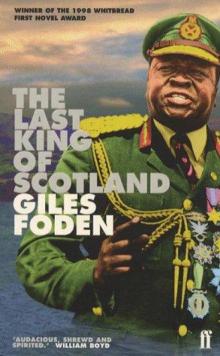 The Last King of Scotland (1998)
The Last King of Scotland (1998)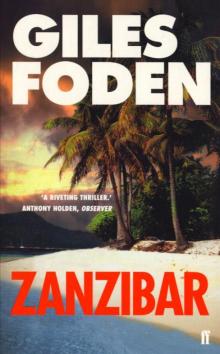 Zanzibar
Zanzibar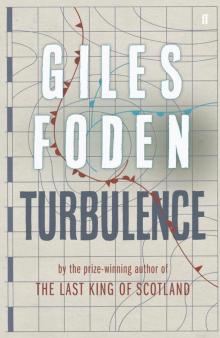 Turbulence
Turbulence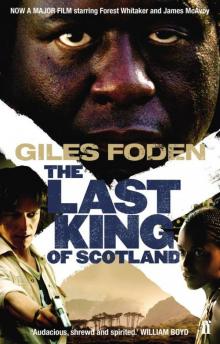 The Last King of Scotland
The Last King of Scotland 1999 - Ladysmith
1999 - Ladysmith 2004 - Mimi and Toutou Go Forth
2004 - Mimi and Toutou Go Forth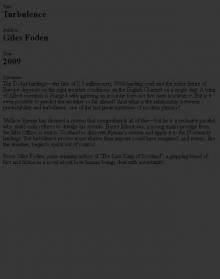 2009 - Turbulence
2009 - Turbulence